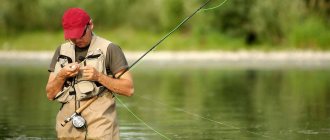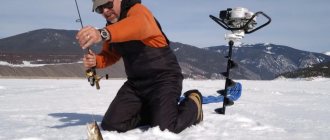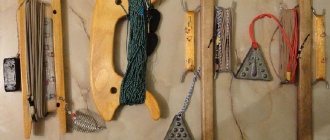How to choose the right fishing rod
A properly selected fishing rod will allow you to easily cast the equipment at the required distance and will help the angler when landing fish. When choosing a fishing rod, you should focus on the type of reservoir where you will be fishing, as well as the type of fish you intend to catch.
Flying float rod
With the right approach, fishing with a float rod from the shore can bring very impressive results. For coastal fishing, a classic fly rod with a blind rig is often used. Fly fishing rods differ from each other in several ways:
- length;
- building;
- manufacturing materials.
When fishing for bleak, short fly sticks with a length of 3 to 5 m are used, which have minimal weight and allow you to throw the equipment with one hand. To catch larger and more cautious fish, rods 6–10 m long are used, with the help of which it is possible to cast the equipment beyond the shore edge.
Fast action rods allow better control of the rig and are well suited for high-speed fishing for small fish. Slow-action rods are more often used when fishing for large fish, as they more effectively dampen the jerking of the trophy during fishing.
Modern fly fishing rods are made of carbon-based composite materials, which gives them maximum lightness and strength. When transporting, the tackle should be stored in a hard tube, since high-modulus carbon does not withstand shock loads well. The equipment is attached to the tip of the rod using a plastic connector.
Design of plug and Bolognese tackle
Plug tackle gives the angler the opportunity to fish with a very thin line and a light float. When fishing with a plug, the angler does not cast the equipment, but delivers it to the baited point by extending the rod, which allows the use of floats of minimal carrying capacity.
The length of plug fishing rods ranges from 10 to 16 m. The working part of the plug is called the “whale”. The length of the “whale” depends on the depth at the fishing site and can be changed by the fisherman during the fishing process. Inside the working part there is a rubber shock absorber that dampens the jerks of the fish when fishing. The shock absorber is passed through the hollow tip of the fishing rod, and at its end a voluminous knot is formed, to which the fishing line will subsequently be attached. The breaking load of the shock absorber is selected taking into account the diameter of the main monofilament.
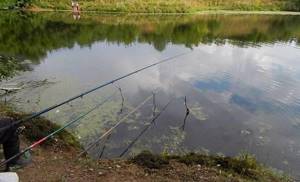
Bolognese tackle is used for fishing with a float on the river and differs from fly fishing tackle in the presence of guide rings. The length of the “lapdog” can be from 5 to 8 m. The longer the rod, the easier it is to control the equipment during wiring. The “Bolonka” is equipped with a spinning reel of size 3000–3500, which is used for casting equipment and landing fish.
Match option feature
Match gear is more often used for float fishing in the fall, when the fish move far from the shore. Match fishing rods have a length from 3.5 to 6.5 m and are equipped with a spinning reel with a large additional number of bearings, which allows you to quickly reel in equipment from a long distance. Match “sticks” differ not only in length, but also in test. The test range is selected taking into account the load-carrying capacity of the float used and can range from 3 to 30 g.
Rods for float fishing
Depending on what type of reservoir and under what conditions the fishing takes place, the angler uses different types of float rods. Fishing rods for float fishing are divided into 4 categories:
- flight feathers;
- Bolognese;
- match;
- plug-in
Flight feathers are the most common group, used for fishing in stagnant bodies of water or on rivers with moderate currents. The casting range when fishing with fly tackle is determined by the length of the rod, which can range from 3 to 12 m. Due to the limited casting range, fly rods are used to fish in small bodies of water or in places where the channel edge or hole is located in close proximity to the shore.
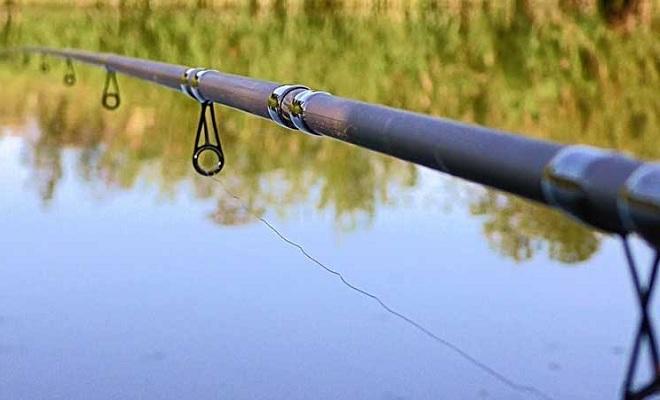
The Bolognese float rod is used for fishing on rivers with weak and medium currents. This tackle is equipped with a spinning reel and rings, which allows you to fish at some distance from the shore. The length of Bolognese fishing rods ranges from 4 to 8 meters.
Match float tackle is used for long-distance fishing. The match fishing rod is equipped with an inertia-free reel and a heavy float with its own weight, which allows you to cast the equipment 30–60 m from the shore. The length of fly rods rarely exceeds 6 m.
A plug rod for float fishing can be used in both standing and flowing reservoirs. It is more often used by sports fishermen, since it requires certain handling skills. Plug fishing rods are equipped with a rubber shock absorber located inside the working part of the rod, which is called the “whale”. The length of such fishing rods reaches 15 m.
Choosing the thickness and structure of the fishing line
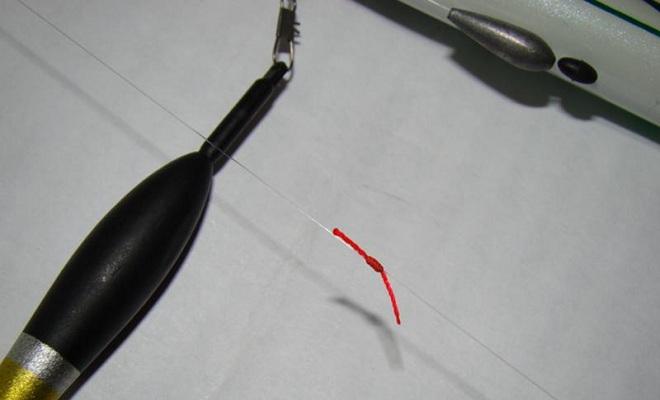
For float fishing, monofilament monofilament threads are used. Monofilament lines have a number of advantages over other types of monofilament:
- good shock-absorbing properties, making it possible to fight large trophies using hooks made of thin wire;
- inconspicuousness in the water, which is necessary when fishing for cautious fish;
- good resistance to abrasive loads, which allows fishing on shell rocks and rocky soil;
- reasonable price, which is several times lower than for braided or fluorocarbon monofilaments.
Monofilaments with a diameter of 0.10–0.20 mm are used as the main fishing line. The thinner the main line, the faster the rig will reach the bottom.
Features of the leash
The leash is also knitted from “monofilament”; its diameter should be 0.02 mm less than the diameter of the main fishing line. A thin leash is less alarming to the fish and prevents the entire rig from breaking when the hook is caught.
The length of the leash when fishing in still water is 15–25 cm, and in currents it is 20–70 cm. If fishing takes place in a flowing body of water, the leash is attached to the main monofilament through a small swivel, which prevents it from twisting in the current. In still water, the “loop to loop” method is used to attach the leash.
Choosing a float for fishing in the current
Exposure to water flow can change the behavior of the float beyond recognition. That is why for river fishing it is recommended to choose special floats suitable for use in currents.
If you are used to fishing in still water, then you have already appreciated the advantages of goose feather and needle floats. With a current, even a slight one, such structures will be completely ineffective - the waves roll them over to one side and, as a result, the floats lie almost parallel to the water surface. Current fishing conditions require a special approach to choosing a float, starting with its design to optimally reduce the negative influence of waves. It is worth paying attention to universal options with the following features:
- egg-shaped (or pear-shaped) with a thin long rod and 2-3 attachment points;
- the body of the float should be located closer to the top edge (serves as a control element);
- the antenna should be much smaller in size than the keel (this will allow the structure to be kept in an upright position even with overactive currents).
It is very important to correctly decide initially on the shape of the body of the float, which will become universal for use in the current, even in windy weather conditions. Drop-shaped models with short antennas meet these characteristics.
Flat floats
Relatively new fishing bite alarms, which have already gained incredible popularity, in particular among fans of plug rods. The almost perfect hydrodynamic shape reduces water resistance to the minimum possible. Even in such powerful currents as on a mountain river, the flat float takes the desired position, remains in an upright position and signals even the most cautious bites.

A flat float made by yourself is not inferior in quality to a purchased one.
Important! The main features of flat floats are a flat body, similar to a disk (it turns with an edge towards the current and, as it were, cuts it, significantly reducing resistance) and a keel installed at an angle (under the influence of the current, it does not allow the structure to heel, keeping it in a vertical position).
Initially, this type of float was recommended only for rivers with active currents. Appropriate loading made it possible to use them in a wide variety of conditions, including in still water when fishing for even the most cautious and timid fish in calm weather and in rain.
Choosing a float depending on the intensity of the current
When trying to catch trophy river fish, it is necessary to take into account all the nuances. One of the subtleties is the correct selection of the weight of the float for flows of different speeds/intensities. In this case, the following recommendations will be useful:
Fishing in early spring with a float
- For weak currents. Floats that can withstand a load of 4 to 8 grams are suitable. It is very important to pay special attention to loading, using heavy and light pellets at a distance of at least 20 cm from each other. In this case, the bait smoothly sinks into the water without scaring the fish and at least 10 cm of the leash should lie quietly on the bottom. With such equipment you create conditions under which it is easy to notice bites from even the most cautious individuals of chub, roach and ide.
- For middle flow. You will need a float with a carrying capacity of 6 to 20 grams, which should be used with a leash of at least 60 cm and no more than 150 cm in length (it is assumed that most of it will lie on the bottom). When loading the pellets, it is necessary to place them closer to the leash and make the distance between them no more than 10 cm. Such equipment in the middle current holds the float in a comfortable vertical position and will promptly notify you of bites from carp and bream.
- For strong currents. It is necessary to use a stable float with a load capacity of 8 to 40 g. The length of the leash increases to two meters and the pellets are moved closer to the bottom of the main line during shipment. In order for the finished equipment to be carried away by the current as slowly as possible, it is recommended to hold the spool with your finger when casting and after it, or even block it with the reel bail. This option is great for catching large carp and bream.
Such recommendations can be considered general, combining the main principles of fishing in the current. To get the desired catch, it is better to experiment not only with the bait, but also with the equipment - to quickly remove and replace it, use a mount with micro-swivels.
Which float to choose
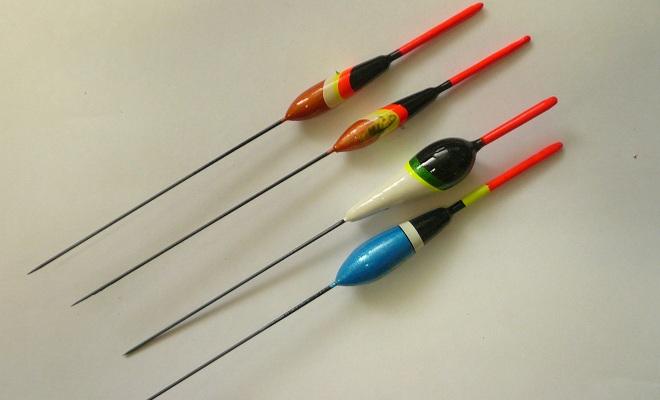
Floats with a carrying capacity of 0.2 to 6 grams are installed on the fly rod, which have several attachment points and are distinguished by their oblong shape. The elongated shape facilitates the stable position of the alarm during wiring.
The Bolognese tackle is equipped with a spherical float, since a spherical signaling device is more stable in the current. The carrying capacity of such a float ranges from 2 to 15 g. The line is passed through the body of the alarm, which protects the body of the float from damage during vigorous hooking.
For fishing with a plug in still water, light floats with a carrying capacity of 0.2–1.5 g are suitable. If fishing takes place in the current, you will need to use flat alarms that have good hydrodynamics and operate stably even in a strong stream.
When fishing for fish using match gear, floats with a weight built into the body, 20–40 cm long and a load capacity of 2–30 grams, are used. Thanks to these characteristics, match alarms can be thrown 50–60 m.
Fishing in the middle reaches
For such conditions, select a float with a carrying capacity of 6 to 20 grams. A short leash will not be effective, so you need to take a piece of fishing line 60-150 cm long. Moreover, the main part of the leash should be at the bottom. The bulk of the pellets are located near the leash, and smaller pellets are attached every 10 cm.
The rod should be directed so that the leash with the hook and bait is carried forward by the current from the float. In this case, the float will not lie on the water, and the bait will sink to the bottom and will not have time to be carried away by the current.
FISHING with a FLOAT in a QUICK CURRENT
Types and shapes of sinkers
For this type of fishing, classic round lead sinkers, which have different weights and sizes, are better suited. Some anglers prefer elongated weights, believing that they are less likely to tangle the equipment. To load large bite alarms, whose carrying capacity is more than 3 grams, you can use an olive sinker, secured on the fishing line with small pellets, as the main load.
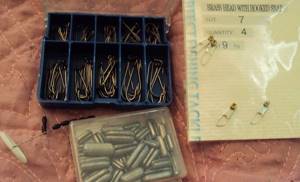
Using a line spool
Float fishing with a Bolognese rod involves the use of a spinning reel, which allows you to cast the equipment to the desired distance. Reels for this type of fishing must have:
- a large additional number of bearings, which ensures quick reeling of the equipment and significantly increases the pace of fishing;
- finely tuned friction brake that prevents the line from breaking in the event of strong fish resistance;
- a spare spool, which makes it possible to quickly reconfigure the tackle;
- even winding of the fishing line, which contributes to the casting distance.
The reel should provide good balancing of the tackle and have a smooth ride. It would be good if the “spinless” vehicle was equipped with a rear friction brake.
Proper equipment of a float rod
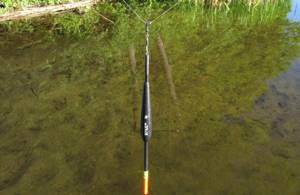
For fishing to be successful, it is important to correctly assemble the float rod equipment. The assembly of the flywheel and plug version is as follows:
- at the end of a piece of monofilament fishing line, a loop is formed, which will subsequently be attached to the connector;
- the float is put on the main fishing line and attached to it using cambrics;
- a small loop is formed at the lower end of the monofilament for attaching the leash;
- a small sinker is installed close to the loop;
- a group of sinkers is attached 30 cm above, whose mass is about 30% of the total weight of the float;
- the main set of weights is installed half a meter higher;
- A leash with a hook is attached to the bottom loop using the “loop-to-loop” method.
The length of the rig should be 10–20 cm less than the length of the rod. An elastic band is put on the butt of the fishing rod, which serves to hook the hook.
The Bolognese version is equipped with one sinker. The load should be made in a sliding version, which will not allow the fish to feel its weight when biting. The equipment of the match tackle differs from the fly and Bolognese tackle in that the bulk of the weights are concentrated in the body of the bite alarm or moved close to it. This distribution of sinkers eliminates overlapping of the equipment when performing long casts.
Fishing in weak currents
For such fishing conditions, it is enough to load the float weighing from 4 to 8 grams. In this case, a leash 10 cm long is enough, which should be located at the bottom. Above the leash, every 10 cm, three small pellets are attached, which are needed to regulate the speed of lowering the bait to the bottom.
Massive pellets are located directly behind the leash. This type of rig allows the bait to sink slowly without spooking the fish. With such tackle you can catch ide, rudd, roach, etc.
How to fish with a float
After the tackle is assembled, you can proceed directly to fishing. Before you start fishing, you should decide on the fishing location, and also prepare the bait and bait mixture.
Searching for a promising location and determining the depth
For fishing with match and plug tackle, you need to choose places free from trees, where you can easily perform various manipulations with a long rod.
Since the casting range is limited by the length of the fishing rod, you need to look for a place on the reservoir where there is a hole or a channel edge near the shore. When fishing with a lapdog on a river, preference should be given to places with a clean bottom, which will prevent frequent snags of the hook on underwater obstacles. It’s good if there is a deep hole near the fishing point in which the fish settle.
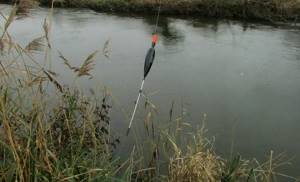
Fishing with a float using a fly rod is possible almost anywhere in the reservoir, since this tackle allows you to throw the equipment to a promising point located far from the shore. To quickly and accurately measure depth, a small depth gauge weight weighing 5–10 g is attached to the hook.
Nozzles
Animal baits such as worms and maggots work better in early spring. When the water has warmed up above 12 degrees, you can switch to attachments of plant origin, which include:
- semolina dough;
- talker;
- Hercules;
- corn;
- pearl barley;
- bread crumb.
In autumn, fish bite better on bloodworms. Fish preferences can change throughout the day, so an angler should take at least 3 varieties of bait to a pond.
Flavors

In warm water, the bait and bait can be flavored with flavors with a pronounced sweet smell. If the water has cooled below 12 degrees, then spicy aromas are used to improve the bite:
- coriander;
- pepper;
- caraway;
- curry.
You should not treat all existing bait or bait with flavoring. With each cast of the bait, it is necessary to change the scent, gradually selecting the scent that arouses more interest in the fish.
Lure
Bait is an essential component of float fishing. For fishing, both purchased and homemade mixtures are used. The basis of a homemade bait mixture can be:
- breadcrumbs;
- wheat bran;
- corn flour;
- sunflower and hemp cake;
- various cereals.
To increase the fish-attracting effect, flavors and animal components are added to the bait. If fishing takes place in a reservoir with a strong current, then soil must be added to the bait.
Fishing technique
Arriving at a pond, the angler chooses a suitable place and mixes the bait mixture. While the bait is infusing, the fisherman sets up a chair, collects the gear and measures the depth in the fishing area. From the present bait, 5-6 lumps the size of an orange are formed and thrown into the fishing point. Throughout the fishing, the angler regularly supplements the fish by throwing balls the size of a walnut into the water.
After feeding, the fisherman baits the hook and throws the equipment into the baited area. Fish usually come up for bait within 10–30 minutes. After the bite, there is an immediate hooking followed by landing the fish.
How to rig a fishing rod
Many anglers prefer two rigging methods: sliding and blind installation. These two types of components are similar in assembly. The only exception is the float, which can be attached in different ways.
Line selection
A monofilament line is a more suitable option for catching fish over 1 kg, since a break may occur at the last moment of fishing. The fish will desperately resist. And the stretchable fishing line will not allow the tackle to break.
Fishing lines are produced in whole series for a specific purpose. For catching heavyweights and fishing in frosty conditions.
Manufacturers began to produce fluorocarbon fishing line to replace monofilament line. This line is more expensive in price. Its most significant advantage is its invisibility in the water. It becomes absolutely invisible to the fish, which increases the likelihood of fishing success. If you don’t have enough money to buy a reel, you can purchase several meters of fluorocarbon fishing line and tie it to the main one.
For match rods, the weight of the line is considered an important factor. Because fishing is carried out at a great distance from the shore and the possible wind can be annoying. Therefore, it is recommended to buy weighted options that float in the water.
When purchasing a braided fishing line, you may encounter the fact that during hooking the fish lip will break. The fish begins to flop around, a hole is formed in the place where the hook is caught and the prey can jump off. There is an important advantage - this is the opportunity to catch a truly massive specimen. Because the fishing line is not inferior to its analogues in strength.
Choosing a float
There are many floats available and it is difficult for beginners to make the right choice. In fact, all float models are designed for certain conditions and equipment. If, as an example, we consider fishing with a fly rod in a calm current, then we should make a choice for a moderate carrying capacity and weight of the float. They are attached tightly.
Long floats are highly sensitive. The advantage is that the float is capable of transmitting even the lightest touches of the fish to the bait. But there is also a drawback - the impossibility of fishing during windy conditions. There are ball-shaped models that are not afraid of wind, but their sensitivity is lower. The best option would be a drop-shaped float, since it is moderately sensitive to fish and weather conditions.
For long casts you need a float that has a large carrying capacity. It is equipped with a thick antenna. With such a weighted rig, you can cast 30 meters. The antenna must be bright so that the bite can be seen from afar.
Loading correctly
Modern loading can be provided in the form of a whole chain of fractions. Thanks to this, it is quite easy to adjust the immersion depth of the float by removing or adding pellets .
How to load correctly:
- The task of the sinker is to immerse the float in the water to the antenna mark.
- Additional small weights are designed to calibrate the float. Only the part that is painted in bright colors will remain. The correct weight of the load will not affect the bite, the fish will not even feel resistance.
- For beginners, it is better to use an olive-shaped sinker. And 4 auxiliary pellets are enough. They are secured at a distance of 5 cm from each other.
Selection of hooks
Experts recommend choosing small hooks, but they must be strong. The trick is that the fish can easily swallow the bait. But for larger specimens you should buy appropriate hooks.
Spicy is also equally important. And this is very difficult to determine. During Soviet times, most fishermen checked the point by running the hook along the nail. If after this a scratch remained, then the hook was considered sharp.
A sharp sting is necessary for hooking the fish's lips , as well as for stringing hard baits. For example, if you use pearl barley, an unpleasant situation will occur: even small roach can break off due to the fact that the hook tip does not even show through the bait, therefore, there is simply nothing for the fish to catch on.



